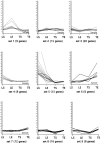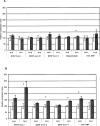Exercise-induced gene expression changes in the rat spinal cord
- PMID: 15892452
- PMCID: PMC6009109
- DOI: 10.3727/000000005783992115
Exercise-induced gene expression changes in the rat spinal cord
Abstract
There is growing evidence that exercise benefits recovery of neuromuscular function from spinal cord injury (SCI). However, the effect of exercise on gene expression in the spinal cord is poorly understood. We used oligonucleotide microarrays to compare thoracic and lumbar regions of spinal cord of either exercising (voluntary wheel running for 21 days) or sedentary rats. The expression data were filtered using statistical tests for significance, and K-means clustering was then used to segregate lists of significantly changed genes into sets based upon expression patterns across all experimental groups. Levels of brain-derived neurotrophic factor (BDNF) protein were also measured after voluntary exercise, across different regions of the spinal cord. BDNF mRNA increased with voluntary exercise, as has been previously shown for other forms of exercise, contributed to by increases in both exon I and exon III. The exercise-induced gene expression changes identified by microarray analysis are consistent with increases in pathways promoting neuronal health, signaling, remodeling, cellular transport, and development of oligodendrocytes. Taken together these data suggest cellular pathways through which exercise may promote recovery in the SCI population.
Figures



Similar articles
-
Exercise restores levels of neurotrophins and synaptic plasticity following spinal cord injury.Exp Neurol. 2005 Jun;193(2):411-9. doi: 10.1016/j.expneurol.2005.01.015. Exp Neurol. 2005. PMID: 15869943
-
Exercise-induced gene expression in soleus muscle is dependent on time after spinal cord injury in rats.Muscle Nerve. 2004 Jan;29(1):73-81. doi: 10.1002/mus.10511. Muscle Nerve. 2004. PMID: 14694501
-
Voluntary exercise induces a BDNF-mediated mechanism that promotes neuroplasticity.J Neurophysiol. 2002 Nov;88(5):2187-95. doi: 10.1152/jn.00152.2002. J Neurophysiol. 2002. PMID: 12424260
-
Voluntary exercise increases neurotrophin-3 and its receptor TrkC in the spinal cord.Brain Res. 2003 Oct 10;987(1):93-9. doi: 10.1016/s0006-8993(03)03258-x. Brain Res. 2003. PMID: 14499950
-
Exercise-induced motor improvement after complete spinal cord transection and its relation to expression of brain-derived neurotrophic factor and presynaptic markers.BMC Neurosci. 2009 Dec 4;10:144. doi: 10.1186/1471-2202-10-144. BMC Neurosci. 2009. PMID: 19961582 Free PMC article.
Cited by
-
Neurotrophin-4/5 is implicated in the enhancement of axon regeneration produced by treadmill training following peripheral nerve injury.Eur J Neurosci. 2011 Jun;33(12):2265-71. doi: 10.1111/j.1460-9568.2011.07724.x. Epub 2011 May 30. Eur J Neurosci. 2011. PMID: 21623957 Free PMC article.
-
Role of exercise in maintaining the integrity of the neuromuscular junction.Muscle Nerve. 2014 Mar;49(3):315-24. doi: 10.1002/mus.24095. Epub 2013 Dec 17. Muscle Nerve. 2014. PMID: 24122772 Free PMC article. Review.
-
Conserved and differential effects of dietary energy intake on the hippocampal transcriptomes of females and males.PLoS One. 2008 Jun 11;3(6):e2398. doi: 10.1371/journal.pone.0002398. PLoS One. 2008. PMID: 18545695 Free PMC article.
-
Gene expression atlas of the mouse central nervous system: impact and interactions of age, energy intake and gender.Genome Biol. 2007;8(11):R234. doi: 10.1186/gb-2007-8-11-r234. Genome Biol. 2007. PMID: 17988385 Free PMC article.
-
Downstream Consequences of Exercise Through the Action of BDNF.Brain Plast. 2015 Oct 9;1(1):143-148. doi: 10.3233/BPL-150017. Brain Plast. 2015. PMID: 29765838 Free PMC article.
References
-
- Abe Y.; Nakamura H.; Yoshino O.; Oya T.; Kimura T. Decreased neural damage after spinal cord injury in tPA-deficient mice. J Neurotrauma. 20:43–57; 2003. - PubMed
-
- Adlard P. A.; Cotman C. W. Voluntary exercise protects against stress-induced decreases in brain-derived neurotrophic factor protein expression. Neuroscience 124:985–992; 2004. - PubMed
-
- Adlard P. A.; Perreau V. M.; Engesser-Cesar C.; Cotman C. W. The timecourse of induction of brain-derived neurotrophic factor mRNA and protein in the rat hippocampus following voluntary exercise. Neurosci Lett. 363:43–48; 2004. - PubMed
-
- Ankeny D. P.; McTigue D. M.; Guan Z.; Yan Q.; Kinstler O.; Stokes B. T.; Jakeman L. B. Pegylated brain-derived neurotrophic factor shows improved distribution into the spinal cord and stimulates locomotor activity and morphological changes after injury. Exp. Neurol. 170:85–100; 2001. - PubMed
-
- Baldi P.; Long A. D. A Bayesian framework for the analysis of microarray expression data: Regularized t-test and statistical inferences of gene changes. Bioinformatics 17:509–519; 2001. - PubMed
Publication types
MeSH terms
Substances
Grants and funding
LinkOut - more resources
Full Text Sources
